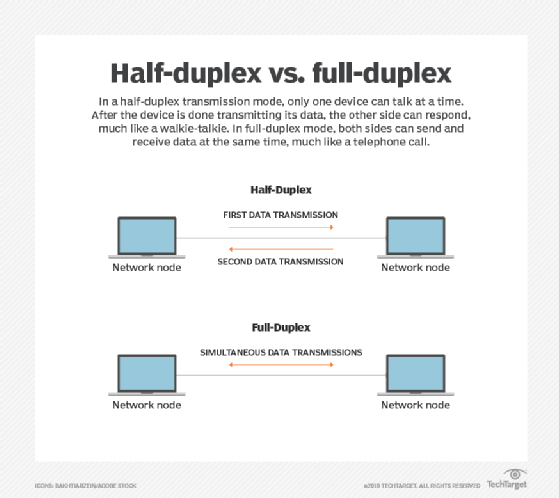collision in networking
What is a collision in networking?
In a half-duplex Ethernet network, a collision is the result of two devices on the same Ethernet network attempting to transmit data at the same time. The network detects the collision of the two transmitted packets and discards them both. Collisions are a natural occurrence on Ethernets.
Ethernet hubs provide a single shared channel, making them half duplex by design. Only one device, or node, on the channel can transmit data at a time. Communication happens only in one direction at a time, as opposed to a full-duplex channel where communication can happen in both directions simultaneously.
What happens when a collision occurs?
On a half-duplex channel, if two devices try to transmit data at the same time, the result is a collision, which can include transmission errors and data loss. When a collision occurs, both devices detect it, and each then waits a random amount of time and retries until successful in getting the transmission sent.
A walkie-talkie is a good example of how a collision occurs in a half-duplex communication channel. These devices can only transmit or receive voice communication in one direction at a time. If the users of two walk-talkies try to speak simultaneous, with both people pressing the push-to-talk button at the same time, neither will hear the other speaker because neither device is in receiving mode.

How are collisions prevented?
Ethernet uses carrier sense multiple access with collision detect (CSMA/CD) as its method of allowing devices to take turns using the signal carrier line. When a device wants to transmit, it checks the signal level of the line to determine whether another data packet is using it. If it's in use, the device waits a few seconds and retries. If it isn't in use, the device transmits.
An alternate collision-avoidance method is carrier sense multiple access with collision avoidance (CSMA/CA). This approach uses an algorithm that sets up schedules of when devices can transmit. This approach reduces the likelihood of packet collisions. When a collision occurs, the packets are discarded and the process resumes.
CA technology optimizes bandwidth by reducing the frequency of collisions, not eliminating them completely. CSMA/CA is well-suited for wireless networks because wireless access points might be out of range of other access points, and the network might not be able to anticipate when devices will attempt to transmit. The use of CA establishes a schedule for devices to transmit regardless of their location.
The best remedy for collisions is to upgrade to a full-duplex switched environment. Network switches break up collision domains so that each device is on its own network segment. This eliminates collisions.
CSMA/CD vs. CSMA/CA
Both CSMA/CD and CSMA/CA are proactive ways to prevent network collisions. CSMA/CD is also called the access method. It assumes collisions will occur on computer networks and uses proactive detection to prevent them. It instructs the various network devices on how they should perform when on the network.
By contrast, CSMA/CA tells devices in a network segment within a broadcast domain when it is OK for them to transmit data. This scheduling approach keeps collisions to a minimum by preventing simultaneous data transmissions from happening.
Learn more about how Ethernet has evolved since it was first introduced in 1973.








